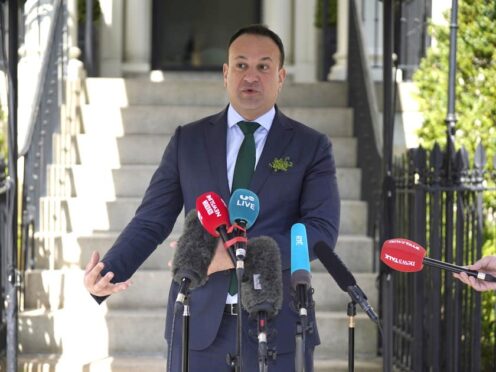Leo Varadkar became Ireland’s youngest ever Irish premier when he took up the reins of the government at the age of 38 in 2017.
His rise to the top made history as he became the first person from an ethnic minority to become taoiseach and he is also the country’s first gay leader.
Born in Castleknock in 1979, Mr Varadkar is the son of an Irish nurse and an Indian doctor.
He joined the centre right youth wing of the Fine Gael party while studying medicine at Trinity College Dublin.

At the age of seven, he announced he wanted to become the minister for health when he grew up.
“My mum wanted me to be a doctor like my dad, and at seven, I really wanted to be a politician, and I managed in my mind to combine the two,” he once said in an interview.
After succeeding Enda Kenny to the role of Fine Gael leader, Mr Varadkar held the post of taoiseach from 2017 until 2020, and then returned to the role in 2022 following an historic agreement with Fine Gael coalition partners Fianna Fail and the Green Party.
Now aged 45, he has made the shock decision to step down as Taoiseach.
On Wednesday, Mr Varadkar made his way to the front doors of Government Buildings, joined by his ministerial party colleagues.
At 12.14pm he delivered his resignation statement, to the surprise of many in Government circles and across the political establishment.
Emotional and holding back tears, Mr Varadkar struggled as he said he was no longer the best person for the job.
His speech was met with rapturous applause from ministers and party staff gathered on the steps at the Merrion Street office.

It was during a radio interview in January 2015 that Mr Varadkar came out as gay and said he would be campaigning in support of the same-sex marriage referendum later that year, some 22 years after homosexuality was decriminalised in the Republic.
He has been in a long-term relationship with doctor Matthew Barrett.
While his election as taoiseach was feted as Ireland’s transition from a conservative Catholic country to an outward-looking socially liberal one, Mr Varadkar’s own political views are conservative.
While social protection minister Mr Varadkar launched a campaign on welfare cheats, he advocates free markets and only made known his pro-choice views on abortion in the run-up to the historic referendum in 2018.
During Mr Varadkar’s time as taoiseach, Ireland passed the landmark referendum to liberalise its strict abortion laws.
He also played a key role in the Brexit negotiations, with a famous meeting with then-prime minister Boris Johnson at a manor house on the Wirral in England seen as a significant moment in paving a way for the deal on the UK’s exit from the EU.
The agreement staved off the prospect of a hard trade border being introduced on the island of Ireland, but it did prompt years of further political turmoil, particularly within unionism in Northern Ireland, over the creation of a so-called Irish Sea border on the movement of goods between the region and Great Britain.

Mr Varadkar was taoiseach at the onset of the Covid pandemic in 2020 and announced a lockdown in arguably his most famous address while on an annual St Patrick’s Day trip to Washington DC.
His detractors will point to Ireland’s ongoing housing shortages and chronic problems within the health service as his government’s major failings.
The political establishment in Ireland has also been under increasing pressure on migration issues over recent times, with an influx of tens of thousands of Ukrainian refugees and asylum seekers from elsewhere in the world heaping further strain on state services and accommodation stock.
His party suffered a major blow when Fine Gael lost seats in the 2020 general election, which ultimately led to the historic coalition with its biggest political rival, Fianna Fail, and the Green Party.
The Government suffered another major defeat after it lost the recent twin referenda on family and care.
The result on the care issue was the greatest loss of a referendum in the history of the state.
In his resignation speech, Mr Varadkar cited the development of the National Broadband Plan, increasing public infrastructure spending in housing, healthcare facilities, schools and climate action and the welcoming of Ukrainians as some of his achievements.
He also pointed out that he will leave office as the institutions under the Good Friday Agreement are working again and the country’s trading relationship with the UK in the post-Brexit era is stable.
The findings of the most recent poll revealed that Mr Varadkar’s approval rating is sitting at 41%, ahead of Sinn Fein leader Mary Lou McDonald with a rating of 39%.
But Fine Gael now faces a difficult few months as it battles to find a replacement leader who will bear the tough responsibility of steering the party through a general election.
